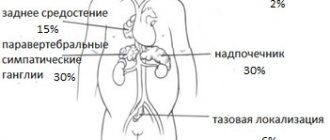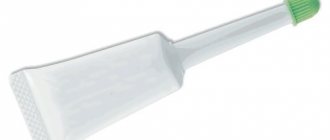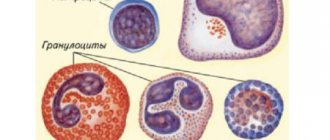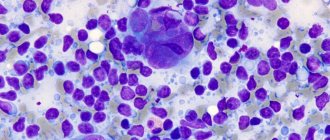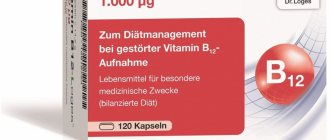High temperature in children is a symptom of many diseases, acute and chronic pathologies of internal organs, infectious processes or allergic reactions.
1. Temperature norms for children of different ages
2. High temperature in children: what can this symptom indicate?
3. Treatment methods
3.1 Is it worth reducing high fever in children?
3.2 General recommendations
3.3 Drug treatments
In some cases, it is the only reason to see a doctor, but more often the disease can be determined by additional clinical signs. It is difficult to carry out a full diagnosis at home, so it is recommended to consult a specialist when the first alarming symptoms appear. The Clinical Brain Institute is a team of experienced professionals whose many years of experience allow us to timely determine the cause of a child’s fever and prescribe an effective treatment regimen.
What body temperature is considered elevated in a child?
To begin with, it is worth deciding on normal temperature indicators. Body temperature is considered elevated if it:
- above 37.2°C in the armpit and scalp
- above 37.8°C in the oral cavity
- above 38°C in the rectum and auricle.
For babies under one year old, a higher figure will be considered normal - up to 37.4 ° C in the armpit.
During the coronavirus pandemic, these temperature indicators can be considered one of the symptoms of COVID-19. To exclude this infection, an in-person consultation with a doctor is required.
In what cases should you call a doctor?
It may happen that the temperature of 37-37.5°C lasted for several days, after which the child’s condition began to deteriorate. This situation requires urgent medical intervention. The reason to call a doctor is if the child has the following symptoms:
- temperature that has risen to 39°C or more;
- difficulty breathing or shortness of breath;
- there are signs of dehydration;
- the child has vomiting and diarrhea;
- chronic diseases have worsened;
- The child began to have convulsions and numbness in his limbs.
Parents should soberly assess the situation and seek qualified medical help in a timely manner without triggering the situation.
Which thermometer is best to use to measure temperature?
There are three types of thermometers used to measure a child's body temperature:
- mercury is the most common thermometer. Its advantage is that such a device measures temperature more accurately than others. The downside is fragility. This is the least preferred way to measure temperature in children. A mercury thermometer is easy to break. The baby may be injured by shrapnel. And mercury is dangerous to health;
- electronic - a simple, modern and convenient thermometer. It is the one that is preferable for children. The downside may be its accuracy. Before using the device for its intended purpose, you should compare its readings with the readings of a mercury thermometer. Take several measurements with both devices on a healthy, adult family member. If the readings differ by no more than 0.1°C, then such a thermometer can be placed in a home medicine cabinet;
- infrared - the advantage of such a thermometer is that it is more accurate than an electronic one. Measures temperature quickly. You don’t need to hold it for a long time, you just need to apply it to the skin for a few seconds. It is very convenient for kids. And also for older children, when you need to measure their temperature while they sleep. The downside is the price - this is the most expensive option. There are different types of infrared thermometers. Some need to be pressed against the skin, others measure temperature at a certain distance from the surface. These thermometers have attachments for measuring temperature in the ear, mouth, and rectum.
For accurate measurements, it is important to use the thermometer correctly. The mercury thermometer must be pressed firmly against the skin. It must be held until the mercury stops rising. Electronic thermometers usually have an audible signal at the end of the measurement. You definitely need to wait for him.
What is a fever?
The normal temperature for babies and children is around 36.4°C, but this may vary slightly from child to child.
- Low-grade fever is an increase in temperature from 36.7 to 38 degrees.
- Fever is a high temperature of 38 C or more.
The following symptoms appear when you have a fever:
- Your baby's forehead, back, or stomach feels hotter than usual.
- The surface of the skin becomes sweaty (moist) and sticky.
- The baby's cheeks and sometimes forehead turn red.
To measure temperature, it is best to use a safe digital thermometer without mercury filling.
What are the causes of high fever in a child?
There are reasons for increased body temperature that are not related to illness.
1. In babies under one year old, due to imperfections in the thermoregulation system, an increase in body temperature may occur as a response to high ambient temperatures. The autonomic nervous system in children is not fully formed, sweating is not perfect, their body cannot adapt to environmental conditions as well and quickly as in adults. In summer, the reason is hot weather. In winter - excessive amounts of clothing.
To prevent your baby from overheating, you need to:
- monitor your drinking regime. In hot weather, it is recommended to give children boiled water;
- walk in the morning or evening hours. In hot weather, limit your baby’s stay outside;
- avoid open sun. Walk in the shade of buildings and trees;
- dress children according to the weather. Do not wrap your child too tightly in winter. In hot weather, dress your child in single-layer clothing made from natural, breathable fabrics. Cover exposed areas of the body as much as possible to avoid sunburn. Don't forget about hats. Choose a light color for them;
- try, if possible, to avoid or reduce the time of traveling with a child in transport;
- For older children, it is quite possible to organize water procedures in the fresh air.
2. An increase in temperature in a small child may occur as a reaction to vaccination. Typically, such an increase is short-lived - one or two days. The readings on the thermometer, however, do not reach too high numbers - up to 38.5°C. There is nothing wrong with such a reaction to the vaccine. On the contrary, this may indicate that the baby is developing a strong immune system.
Typically, this condition does not require any special actions from parents. Just care and drink. If the child is feeling unwell, the temperature can be brought down in the same way as with any other condition. If the temperature rise lasts for a long time, the numbers on the thermometer are too high, or the baby has other complaints, a pediatrician’s consultation is necessary.
Read more about post-vaccination reactions in children in our article “What can happen to a child after vaccination?”
3. Sometimes an increase in temperature in a child is associated with a disruption of the nervous system. In this case, the temperature remains for a long time, does not reach high numbers and does not affect the general well-being of the child. The reason for this increase in temperature is trauma or previous infections of the brain. For example: concussions, brain contusions, meningitis or encephalitis. This condition requires contacting a pediatrician and neurologist, additional examination and specific treatment.
4. The most common cause of high fever in a baby is infection. We will talk about it in more detail.
Herpesvirus infections
Herpes virus infections are caused by herpes simplex viruses types 1 and 2. The onset of herpetic infection in children is often accompanied by a temperature of 39–40°C and stomatitis (painful rashes on the oral mucosa, Fig. 1). This makes eating difficult and causes the child to refuse food.
Figure 1. Manifestations of stomatitis. Source: mrfiza / Depositphotos
Herpetic stomatitis most often occurs in children under three years of age. They are especially difficult for babies in the first month of life. In this case, small blisters may appear on a reddened base on the skin, mucous membranes of the mouth and eyes.
In children in the first month of life, herpes is often accompanied by inflammation of the brain and meninges (meningoencephalitis), since this virus “loves” to settle and multiply in the nervous tissue.
A type of herpes infection is EBV infection (caused by the Epstein-Barr virus or herpesvirus type 4). According to statistics, about 50% of children under the age of 5 years have already suffered from this infection.2 Fever, enlargement of all groups of lymph nodes (especially cervical), inflammation of the tonsils and the appearance of rashes after the use of penicillin antibiotics are its typical symptoms.
Childhood infections with rash
Children's infections with the presence of a rash are also called “infectious exanthemas.” Based on the nature of the rash, the doctor will make a diagnosis and determine the cause of the child’s fever. Infectious exanthemas include chicken pox, measles, sudden exanthema, scarlet fever.
Chicken pox
Chickenpox is a highly contagious disease with airborne transmission. It is caused by herpes virus type 3 (Varicella Zoster). The chickenpox rash is characterized by swollen pale pink spots with a vesicle in the center, its size is 1-3 mm. The main difference between this rash is that at the same time there may be spots, blisters and crusts on the body, since some are just appearing, while others are already passing.
The rashes are localized on the scalp, face, neck, torso, and limbs (Fig. 2); there may be elements of the rash on the mucous membranes of the mouth, throat, genitals, and sometimes in the eye area. After a few days, the blisters dry out and form crusts, which eventually break off on their own.
Figure 2. Chickenpox rash in a child. Source: pavsie / Depositphotos
The rash may be accompanied by itching. When combing them or tearing off the crusts, small scars form on the skin.
In most cases, chickenpox in children is relatively mild. The severity of chickenpox depends on the severity and duration of the fever. In severe cases, it lasts up to 14 days. Complications such as pneumonia and encephalitis (inflammation of the brain) are possible.
Measles
Measles is an extremely contagious viral infection. It is also called “childhood plague.”3 Despite mandatory immunization, the measles epidemiological situation in Russia cannot be considered favorable, since there is not a sufficient number of vaccinated people.4
The infection begins with respiratory symptoms against a background of high temperature: runny nose, sneezing, dry cough, swelling and inflammation of the eye mucosa, photophobia. From the second day of illness, small white spots with redness at the edges (Filatov-Belsky-Koplik spots) can be seen on the mucous membrane of the cheeks. On days 4–5 of the illness, a characteristic rash appears on the face, neck and behind the ears in the form of pink and red spots, which gradually spread from top to bottom and tend to merge (Fig. 3). Then they peel off, accompanied by light brown pigmentation. Measles is dangerous due to its complications. This can be pneumonia, otitis media, encephalitis with subsequent disability.
Figure 3. Measles: rash on the face, torso and arms (second day of the rash period). Source: PHIL CDC
Sudden exanthema
Sudden exanthema (infantile roseola, pseudorubella, sixth disease, three-day fever) is an infection caused by herpesviruses types 6 and 7. Children aged six months to two years are most vulnerable. As the disease progresses, rashes appear: small pink spots with maximum localization in the torso area. They turn pale when pressed and may itch. Before the appearance of roseola, a temperature of 38–40 ° C is noted without symptoms, and the posterior cervical and mandibular lymph nodes may enlarge.
Scarlet fever
Scarlet fever is a bacterial infection in which, in addition to fever, a sore throat develops and a rash appears, which is caused by the absorption of the pathogen's toxin, beta-hemolytic streptococcus. Scarlet fever rashes are bright red, 1–2 mm in diameter, slightly rough to the touch. Characteristic features include a “strawberry tongue” (with emphasized papillae) and pallor of the nasolabial triangle. In the axillary and inguinal folds, the color of the rash is more saturated.
After the rash resolves, slight peeling appears on the skin in the form of “thin layers” on the fingers and toes. 2–5 weeks after scarlet fever resolves, complications such as rheumatism, glomerulonephritis, and psoriasis are possible.
Enteroviral infections
About 100 varieties of viruses are known (Enterovirus, Coxsackie, ECHO, etc.), which cause outbreaks of diseases mainly in the summer-autumn period, during summer holidays at sea.
Signs of enterovirus infection vary among different types of enteroviruses. Enteroviral fever occurs like the flu, when there is a sharp fever and muscle pain, headache, nausea, vomiting, and diarrhea may appear. In some cases, herpangina develops - painful blisters appear on the oral mucosa.
With some types of enterovirus infections, a characteristic rash appears on the palms, soles and oral mucosa (hand-foot-mouth syndrome or viral pemphigus).
The intestinal form of enterovirus infections is accompanied by watery diarrhea up to 5–10 times a day, abdominal pain, and infrequent vomiting. In children under one year of age, this form of infection can cause dehydration.
Epidemic myalgia is also a manifestation of enterovirus infection. It is characterized by pain in the chest and abdomen, aggravated by breathing and coughing.
The most severe manifestations of enterovirus infections can be meningitis and encephalitis - brain damage with vomiting, convulsions, weakness in the limbs, and impaired consciousness.
Tick-borne encephalitis
Tick-borne encephalitis is a severe viral disease that occurs in areas inhabited by ixodid ticks (Siberia, the Far East, central Russia, Ukraine).
Infection occurs as a result of infection with the virus after being bitten or crushed by a tick. It is possible to get infected by consuming unboiled milk from cows, goats and sheep.
Clinical manifestations of the disease begin on average after two weeks, accompanied by a temperature of 38–40°C, headache, muscle aches, photophobia, discomfort in the eye area, oculomotor disorders, movement disorders, convulsions, and possible loss of consciousness.
Tick-borne encephalitis can cause irreversible health problems. To prevent the disease in endemic areas, immunoprophylaxis with a vaccine and specific immunoglobulin is used.
Bacterial infections
Among the pathogens in children, the most important are Escherichia coli, beta-hemolytic streptococcus, staphylococcus, pneumococcus, Haemophilus influenzae, salmonella, and enterobacter. These pathogens cause bacterial pneumonia, infections of the skin and subcutaneous tissue, genitourinary tract, and intestines. The most common cause of a high fever in an asymptomatic child is a bacterial urinary tract infection.
Non-infectious causes of high fever
Non-infectious causes of high fever are less common. They can be presented:
- Reactions to various medications and vaccines. Among such drugs, antibiotics and sulfonamides are in the first place, as well as vaccines against whooping cough, measles and influenza, pneumococcus, and tuberculosis.
- Autoimmune diseases: lupus erythematosus, vasculitis, juvenile arthritis, ulcerative colitis (inflammatory bowel disease).
- Dysfunction of the central nervous system against the background of traumatic brain and birth injuries, cerebral hemorrhages, prolonged psycho-emotional stress.
- Teeth growth.
- Overheating in the sun.
In some cases, the cause of high temperature is malignant tumors (leukemia, lymphoma).
Why does the temperature rise during illness?
It must be remembered that high temperature during infection is a protective mechanism. In response to a virus or bacteria entering the blood, the cells of our body begin to produce pyrogens (substances that cause an increase in body temperature, fever). They stimulate certain parts of the nervous system responsible for thermoregulation. The nerve endings of these sections give the blood vessels a signal to contract. This is how the body retains the heat it already has. Therefore, a child with fever looks pale.
At this time, muscle tissue receives a signal for active work. This allows the body to produce more heat. That's why the baby is shivering. When the temperature reaches the optimal level, according to our nervous system, the body gives the command to dilate the blood vessels. The child's skin turns red, the shaking stops, and sweating begins. This happens at approximately 38.5-39°C. Why at these numbers?
Firstly, at this temperature, inflammatory mediators are produced - substances that fight infection in our body.
Secondly, high temperature prevents the growth of bacteria.
It turns out that a high temperature is not at all scary, and is even very useful during an infection. If the child tolerates the elevated temperature well, you can not rush to bring it down, but let the immune system fight the disease.
What are the causes of low-grade fever?
Failure in the thermoregulation system of a child’s body can be caused by various negative factors, such as changes in air temperature, stress, hormone imbalance or taking medications. These reasons may cause a one-time failure and do not pose a serious health hazard.
An alarming “bell” for parents is repeated temperature rises, or if the elevated temperature lasts for a long time. The reasons can be divided into two large groups:
- Infectious. Infection in 80% of cases is the cause of dysfunction of the thermoregulatory center. The general symptoms are complemented by catarrhal symptoms and signs of intoxication.
- Non-infectious. This group includes systemic diseases, the postoperative period and the period after vaccination, heat stroke, and trauma.
Thus, low-grade fever is the result of a restructuring of thermoregulatory processes, which occurs due to the introduction of infection, allergies or other influences into the body.
When is it necessary to “bring down” a child’s high fever?
1. If a child does not feel well, you should not try with all your might to maintain a high temperature. When the baby is capricious, cannot sleep, complains of a headache, body aches, then the temperature can be brought down. Moreover, in different situations and in different children, this condition can occur with different indicators on the thermometer.
2. There is a conditional criterion that the temperature should not be lowered below 38.5°C, and the temperature above this value must be “brought down”. Actually this is not true. Some babies do not tolerate temperatures of 37.5°C. Others feel quite tolerable even at 39°C. It is not so rare that I meet small patients who play calmly at 38.5°C and above.
3. If the baby has chronic diseases. For example: heart disease, metabolic disorders, neurological diseases. In such cases, there is a risk that an increase in temperature will worsen the course of the chronic disease. It is recommended for such children to “bring down” the temperature above 38-38.5°C.
4. Babies under 3 months of age are not recommended to wait until the temperature rises above 38-38.5°C.
5. If the child has previously had febrile seizures (a seizure that occurs in a child only when the child has a high temperature). Meeting such a patient at a pediatrician’s appointment is not uncommon. Usually this condition is benign and goes away on its own with age, without any treatment. It is recommended for such children to reduce their temperature to 38°C. Numerous clinical studies have proven that taking antipyretics prophylactically for such children (i.e., before the temperature begins to rise), repeating them regularly, regardless of the numbers on the thermometer, is not effective. In the same way as treating such babies with antiepileptic drugs.
6. If the temperature is above 41°C. This is the temperature that is considered critical and dangerous for the baby’s internal organs. With common infections, such figures are rare.
Signs of particularly dangerous diseases accompanied by fever
Fever can be a sign of serious illnesses such as meningitis, urinary tract infection and sepsis. It is necessary to urgently call an ambulance or take the child to the hospital emergency room if he has:
- There is tension and stiffness in the neck muscles,
- A rash has appeared that does not go away when you press on it with a finger
- The child is very irritated by light,
- The attack of fever does not go away, the child “shakes” with chills
- The child has unusually cold hands and feet
- Your baby has pale, mottled, blue, or gray skin
- The baby's crying has become weak, moaning, and does not look like usual
- The baby is sleepy, lethargic, and difficult to wake up
- The child has difficulty breathing, the stomach is pulled in under the ribs when breathing
- In a newborn baby, the fontanel on the top of the head has become bulging
What should you do if your child has a seizure? Seizures are a very serious side effect of fever in some children. Febrile seizures occur in 2–4% of all children under 5 years of age. Not all seizures cause sudden muscle twitching. Some seizures look like “fainting.” If your child develops a seizure, do the following:
- Place your baby on his side.
- Do not put anything in your child’s mouth, even if “experienced” grandmothers recommend doing so.
- Call an ambulance immediately if the attack lasts more than five minutes.
- If the attack lasts less than five minutes, call your doctor or make an emergency visit to your doctor.
How to “bring down” a high temperature correctly?
- You should start by wiping with water slightly warmer than room temperature. In emergency cases with very high numbers, you should not be afraid of a cool shower. It is strictly not recommended to wipe children with alcohol solutions or vinegar. The surface of a child's skin absorbs substances to a much greater extent than that of an adult. Treating the skin in this way can cause poisoning.
- The baby should be given enough water. A lack of moisture in the body reduces sweating. This means that the body cannot fully give off heat and overheats.
- Do not wrap a sick child tightly. If the baby is shivering, this does not mean that he is cold. Do not cover it with a thick blanket and wear many layers of warm clothing.
The room of a sick child should be cool - optimally no higher than 21°C. Otherwise, the body will not be able to give off heat fully.
If physical cooling methods are not effective enough. It makes sense to switch to using antipyretics.
How to care for a sick child at home
For a child with a fever, it is important to create a comfortable environment at home. You should not dress him warmly or wrap him up (except during periods of severe chills); he should be ventilated: the temperature in the room should be 20–22°C.
An ill child becomes lethargic or restless and refuses to eat or drink, which can lead to dehydration with a fever. Therefore, it is important to give your baby water as often as possible. To do this, it is better to use warm or cool compotes, fruit drinks, diluted juices, jelly, and weak tea. Children under two years old should drink about 1 liter of liquid per day, older children - 1.5–2 liters. If your baby is breastfed, you need to put him to the breast more often.
At high temperatures, it is important to maintain a drinking regime. Photo: lia_russy / Depositphotos
An indicator of adequate drinking is passing light-colored urine every 4 hours. It is necessary to monitor the child so as not to miss important symptoms and consult a doctor in a timely manner. Walking and washing a feverish baby should not be done in cases where it makes the child feel uncomfortable.
How to properly use antipyretic drugs for children?
It should be clarified that antipyretic drugs in children are used only when there is already a high temperature. A course of treatment to prevent an increase in body temperature, for example 3 or 4 times a day, does not make sense. There are many trade names and dosage forms adapted for use by children:
- For babies under one year old, antipyretic in the form of suppositories is more suitable. It must be remembered that the effect of drugs in this form occurs somewhat later than that of drugs that are administered orally;
- syrups and solutions are produced for children over one year old;
- Children over 7 years old can already take medications in the form of tablets.
In the instructions for the drugs, a single dose of the drug is usually indicated on average for the age of the child. But it is more correct to calculate the dose not by age, but by weight. Different babies at the same age can vary significantly in weight.
You should know that when taking an antipyretic, the temperature should not reach normal levels. A decrease in temperature of at least 1 degree is considered effective. But, even if the temperature has decreased to a lesser extent, and the child’s well-being has improved, this is already a positive effect from taking an antipyretic.
Online consultation with pediatrician Olga Nikolaevna Tekutyeva
Registration online
During the consultation, you will be able to voice your problem, the doctor will clarify the situation, interpret the tests, answer your questions and give the necessary recommendations.
How to diagnose and how to treat?
As a rule, diagnostic measures for a child with a complaint of low-grade fever include hardware and laboratory research methods:
- examination of ENT organs using appropriate instruments;
- blood test: general, serological and biochemistry;
- sputum examination;
- if necessary, radiography and CT;
- Ultrasound diagnostics;
- echocardiography.
Based on the results of a comprehensive examination, the otolaryngologist makes a diagnosis and makes appropriate prescriptions.
Residents of Kaliningrad can make an appointment with a pediatric otolaryngologist by filling out a preliminary application on our website or calling: +7 (4012) 357-773 or +7 (4012) 973-100.
What medications should children not take to reduce fever?
Nimesulide is prohibited for use in children under 12 years of age. It has a pronounced toxic effect on the liver.
Analgin (metamizole sodium) causes a marked decrease in blood neutrophils, often causing anaphylactic shock. Analgin, unlike other antipyretics, is capable of sharply reducing body temperature to extremely low numbers (34-35°C). It can be taken only in special conditions, under the supervision of a doctor, in the form of injections.
Aspirin (acetylsalicylic acid) is strictly prohibited in children under 15 years of age due to the fact that it causes a severe complication with high mortality - Reye's syndrome.
In conclusion, I want to say that all children, sooner or later in their lives, encounter a high temperature. There is nothing wrong with this if you know how to properly help your baby.
